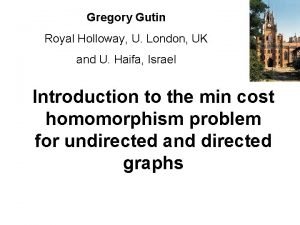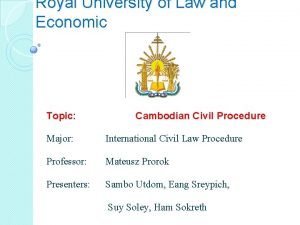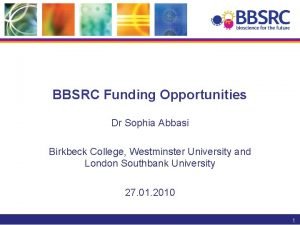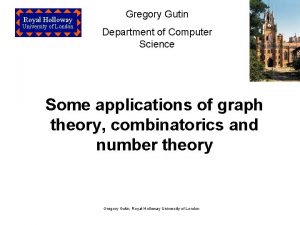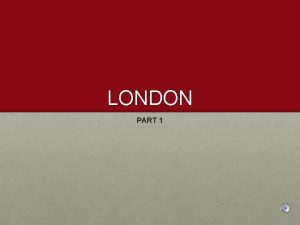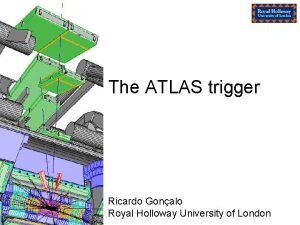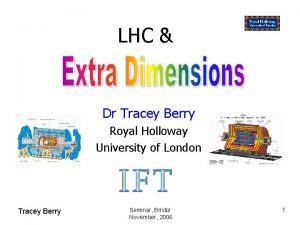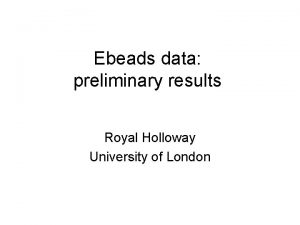Royal Holloway University of London Gregory Gutin Department




















- Slides: 20

Royal Holloway University of London Gregory Gutin Department of Computer Science Some applications of graph theory, combinatorics and number theory Gregory Gutin, Royal Holloway University of London

Royal Holloway University of London Two Parts of the Talk • Graph-Theoretical Approach to Level of Repair Analysis (joint work with A. Rafiey, A. Yeo and M. Tso, Man. U. ) • Mediated Digraphs and Quantum Non. Locality (joint work with N. Jones, Bristol U. , A. Rafiey, S. Severini, York U. , and A. Yeo) • www. cs. rhul. ac. uk/~gutin/pppublications. html Gregory Gutin, Royal Holloway University of London

Royal Holloway University of London LORA • Level of Repair Analysis (LORA) procedure for defence logistics • Complex system with thousands of assemblies, sub-assemblies, components, etc. • Has λ ≥ 2 levels of indenture and with r ≥ 2 repair decisions (λ=2, r=3: UK and USA mil. ) • LORA: optimal provision of repair and maintenance facilities to minimize overall lifecycle costs Gregory Gutin, Royal Holloway University of London

Royal Holloway University of London LORA-BR • Introduced and studied by Barros (1998) and Barros and Riley (2001) who solved LORA-BR using branch-and-bound heuristics • We show that LORA-BR is polynomial-time solvable • Proved by reducing LORA-M to the max weight independent set problem on a bipartite graph Gregory Gutin, Royal Holloway University of London

Royal Holloway University of London LORA-BR Formulation-1 • λ=2: Subsystems (S) and Modules (M) • A bipartite graph G=(S, M; E): sm ε E iff module m is in subsystem s • r=3 available repair decisions: "discard", "local repair" central repair“: D, L, C (subsystems) and d, l, c (modules). • Costs (over life-cycle) c 1, i(s), c 2, i(m) of prescribing repair decision i for subsystem s, module m, resp. Gregory Gutin, Royal Holloway University of London

Royal Holloway University of London LORA-BR Formulation-2 • We wish to minimize the total cost of choosing a subset of the six repair decisions and assigning available repair options to the subsystems and modules subject to: • R 1 : D s → d m, R 2: l m → L s Gregory Gutin, Royal Holloway University of London

Royal Holloway University of London LORA-BR Formulation-3 • Assign colors 1, 2, 3 to vertices of G instead of the repair options • Define the color correspondence D → 1, C → 2, L → 3; d → 3, c → 2, l → 1 • R 1 (R 2) means that if u in V 1 (V 2) is assigned color 1, all its neighbors must be assigned color 3 • An assignment of colors to vertices of G satisfying R 1 and R 2 is called an R 1&R 2 acceptable coloring Gregory Gutin, Royal Holloway University of London

Royal Holloway University of London LORA-BR Formulation-4 • We may replace R 1 and R 2 by a bipartite graph FBR with partite sets {1', 2', 3'} and {1'', 2'', 3''} and with edges {1'3'', 2'2'', 3'3'', 3'2'', 3'1''} • Indeed, in an R 1&R 2 -acceptable coloring, we may assign color j to a vertex u in V 1 and color k to a vertex v in V 2 iff j'k'' in E(FBR) Gregory Gutin, Royal Holloway University of London

Royal Holloway University of London LORA-BR Formulation-5 • LORA-BR as a purely graph-theoretical problem: • Given: bipartite graph G=(V 1, V 2; E), real costs cj(u) of assigning color j in {1, 2, 3} to a vertex u in V=V 1 U V 2. Also, real costs cij of using color j for vertices of Vi, i ε {1, 2}, j ε {1, 2, 3}. • Objective: For each i=1, 2, we choose a subset Li of {1, 2, 3} and find an R 1&R 2 -acceptable coloring of the vertices of G that minimizes ΣuεVck(u)(u)+ ΣjεL 1 c 1 j+ ΣjεL 2 c 2 j where ck(u)(u) is the cost of assigning color k(u) in Li to u in Vi and cij is the cost of using color j for vertices of Vi Gregory Gutin, Royal Holloway University of London

Royal Holloway University of London General LORA problem • F a bipartite graph (color-acceptability graph) with partite sets {1', …, r'} and {1'', …, r''}. • An assignment of colors from {1, …, r} to V; assigns a vertex u a color k(u) is an acceptable coloring if for each edge uv ε G, u ε V 1, v ε V 2, we have k'(u)k''(v) ε E(F). • For each i=1, 2, we choose a subset Li of {1, …, r} and find an acceptable coloring of the vertices of G that minimizes ΣuεVck(u)(u)+ ΣjεL 1 c 1 j+ ΣjεL 2 c 2 j where ck(u)(u) is the cost of assigning color k(u) in Li to u in Vi and cij is the cost of using color j for vertices of Vi NP-Hard Gregory Gutin, Royal Holloway University of London

Royal Holloway University of London LORA-M • A bipartite graph B with partite sets {1', …, r'} and {1'', …, r''} monotone if p'q'‘ ε E(B) implies that s't'' ε E(B) for each s≥ p and t ≥ q. • The bipartite graph FBR corresponding to both rules of LORA-BR is monotone • LORA-M is the general LORA problem with a monotone color-acceptability graph F. POLYNOMIAL TIME SOLVABLE Gregory Gutin, Royal Holloway University of London

Royal Holloway University of London Solving LORA-M. 1 • c 1(u) ≤ c 2(u) ≤ … ≤ ck(u) for each u ε V • wj(u)=M-cj(u), wij=M-cij ≥ 0 • w 1(u) ≥ w 2(u) ≥ … ≥ wk(u) for each u ε V • Max ΣuεV wk(u)(u)+ ΣjεL 1 w 1 j+ ΣjεL 2 w 2 j • Fix L 1 and L 2 • Max ΣuεV wk(u)(u) Gregory Gutin, Royal Holloway University of London

Royal Holloway University of London Solving LORA-M. 2 • For fixed subsets L 1 and L 2, LORA-M can be solved in time O(n 12 m 1/2+n 1 m). • Graph H with vertices uj: u ε Vi, j ε Li • ujvk be in H if uv ε E(G), u ε V 1, v ε V 2 and j'k'‘ is not in E(F); r(i) = max {p: p ε Li } • For i=1, 2, u ε Vi and j ε Li, let w(uj) : = wr(i)(u)+M, if j=r(i), and wj(u)- wk(u), where k is the smallest number in Li larger than j, otherwise. Gregory Gutin, Royal Holloway University of London

Royal Holloway University of London Solving LORA-M. 3 • H is bipartite • For acceptable coloring k, {uk(u): u ε V(G)} is independent in H • By monotonicity of F, S={ uj: u ε V, j ε Li, j ≥ k(u)} is independent in H • S contains S' ={ ur(i) : u ε V} Gregory Gutin, Royal Holloway University of London

Royal Holloway University of London Solving LORA-M. 4 • G has an acceptable coloring iff a maximum weight independent set in H contains S' • If G has an acceptable coloring, then an optimal acceptable coloring corresponds to a maximum weight independent set S in H (the difference in weights is Mn) Gregory Gutin, Royal Holloway University of London

Royal Holloway University of London Mediated Digraphs • D=(V, A) is mediated if for each pair x, y of vertices either xy ε A or yx ε A or there is a vertex z such that both xz, yz ε A Gregory Gutin, Royal Holloway University of London

Royal Holloway University of London Mediation Number • x ε V: N-(x)={y: yx ε A}, N-[x]={x} U N-(x) • A digraph D is mediated iff for each pair x, y ε V there is a vertex z ε V s. t. x, y ε N-[z] • For a digraph D, Δ-(D)=maxxεV|N-(x)| • The nth mediation number μ(n) is the minimum of Δ-(D) over all mediated digraphs on n vertices Gregory Gutin, Royal Holloway University of London

Royal Holloway University of London Mediated Families • Family F={X 1, X 2, …, Xm} of subsets of a finite set X (of points); subsets of X are blocks • F symmetric if m=|X| • F 2 -covering if for each pair j, k ε X there exists a block containing both j and k • F mediated if symmetric, 2 -covering and has an SDR • mcard(F) max cardinality of a block in F • μ-(n) the minimum mcard(F) over all mediated families on {1, 2, …, n}; we have μ(n)= μ-(n)-1 Gregory Gutin, Royal Holloway University of London

Royal Holloway University of London Proj. Planes and Bounds • Projective plane is a (q 2+q+1, 1)design; exists when q is prime power • Theorem: Let n=q 2+q+1+m(q+1)-r, where q is a prime power, 1 ≤ m ≤ q+1 and 0 ≤ r ≤ q. Then μ(n) ≤ q+m. • Theorem [Baker, Harman and Pintz] For all x>x 0 the interval [x-x 0. 525, x] contains prime numbers. Gregory Gutin, Royal Holloway University of London

Royal Holloway University of London Bounds and Questions • Let f(n)= ┌((4 n-3)1/2 -1)/2┐ • • We have μ(n) ≥ f(n) We have μ(n) = f(n) (1+o(1)) Is there a constant c s. t. μ(n) ≤ f(n) + c ? Is μ(n) monotonically increasing ? Gregory Gutin, Royal Holloway University of London
 Moodle rhul
Moodle rhul Gregory gutin
Gregory gutin Gregory gutin
Gregory gutin Royal holloway my view
Royal holloway my view Royal holloway sociology
Royal holloway sociology Royal holloway semester dates
Royal holloway semester dates Deep q network
Deep q network Royal london medical underwriting limits
Royal london medical underwriting limits London royal docks map
London royal docks map Royal london group subsidiaries
Royal london group subsidiaries Aisha holloway
Aisha holloway Vikki holloway
Vikki holloway Bot-2 메뉴얼
Bot-2 메뉴얼 Why is attending school important
Why is attending school important The british royal university
The british royal university Rule university
Rule university Royal university of agriculture
Royal university of agriculture Royal university of law and economics
Royal university of law and economics Sophia abbasi
Sophia abbasi Arden university campus london
Arden university campus london Napseter
Napseter


